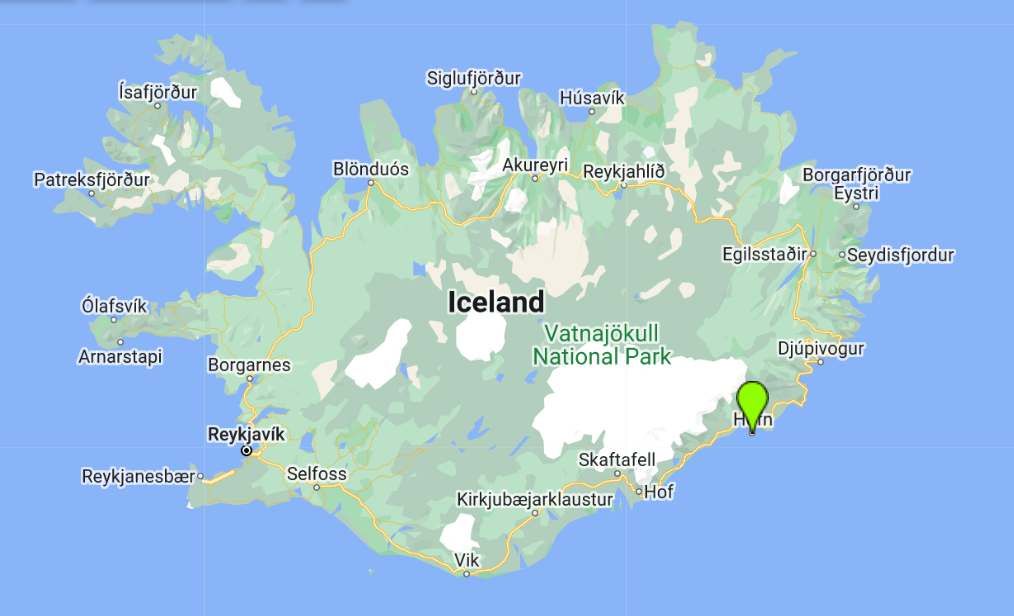Höfn
Höfn Harbour
Anyone who drives the whole of the ring road around Iceland is likely to stop at Höfn. Also known as Höfn í Hornafirði, it is the most significant settlement on Route 1 between the village of Kirkjubæjarklaustur in the south and Egilsstaðir in the east. It makes a natural stopping point, whether for a meal and comfort break or to stay overnight. The stretches of road either side of Höfn are barely populated and offer very few stopping points so although a small town with a population of just over two thousand people, Höfn is well-visited. We drove the ring road anti-clockwise, leaving Reykjavík and driving along the south coast, then spending a few days in the East and returning to Reykjavík via Akureyri in the North. Therefore, after the long but very beautiful stretch of road from Kirkjubæjarklaustur, driving into Höfn felt a bit like coming to a bustling metropolis!
The surrounding landscape is absolutely stunning, with the sea on one side and jagged mountains, wide rivers and the enormous Vatnajökull glacier on the other. Sitting on the stunning Hornafjörður fjord, and beside the largest ice cap in Europe, the views are amazing in every direction.
The landscape surrounding Höfn
The name Höfn means harbour and Höfn has been a settlement for less than two hundred years, officially becoming a town in 1988. Since people first began to settle there it has been an important fishing port. The town’s biggest industries are tourism and fishing, the latter of which is divided into both sea fishing and factory processing. Thanks to the fishing industry and the increasing number of tourists, the town is flourishing. There are hotels, restaurants and campsites, as well as swimming pools, golf courses and, of course, museums. Culture is thriving in Höfn.
One of the reasons that Höfn has such a strong fishing industry is that for some reason the fishing catch here seems to be far more varied than in other fishing towns, and includes high-value species such as the Norway lobster (lobster as we know it – as opposed to what is often called lobster in Iceland which is actually langoustine – equally tasty but much smaller), but a good part of the Icelandic lobster catch is also landed at Höfn. In recent years the town has promoted lobster as a central part of its image, for instance they hold a "lobster festival" every July that has become quite famous. Most of the restaurants feature lobster heavily in their menus – which can only be a good thing! For example, lobster pizza is a big thing here!
We took advantage of the fact that Höfn has many good restaurants to stay in the area for the first night of our trip to the east coast. We had been going to try the Pakkhús restaurant in the harbour which had been highly recommended but it is not possible to book and they were full when we got there, so we tried a lovely cosy place over the road called Otto and had a gorgeous meal including, of course, lobster (langoustine) soup with fresh baked sourdough bread which was superb.
The next day we drove back into Höfn to have a look around the town in the daylight, before heading on to Stokksnes beach. As well as exploring the town itself, we drove out to the southernmost part of the town, Ósland, which is a conservation area, popular for hiking and birdwatching. Ósland was apparently once an island but is now connected to the mainland. There is rich birdlife all around – dominated when we were there by the arctic terns as it is their breeding season, so we were subject to a few rather noisy aerial attacks!
On the hill of Óslandshæð is a memorial to the fishermen that have lost their lives at sea, as well as an information board containing information on the surrounding area.
The memorial to the fishermen who have lost their lives at sea
There is also a vastly scaled down model of the sun with boards giving information about other planets in the solar system. I found out subsequently that there is a hiking trail based on the solar system which is to scale (scaled down to more than 2.1 billion-fold!) with sizes and distances measured correctly. From the sun model on the Óslandshæð hill, which is some 65cm in diameter you can walk to the other planets positioned along the trail, the diameters of which range from 1mm to around 6.5cm. For example, the walk from the sun to the planet Neptune is around 2.8km long and takes around an hour to walk from end to end. Next time we are in the area it would be quite fun to walk around the entire solar system!
From this hill there is a great view over the glacier ring and the mountains stretching from Öræfajökull glacier in the west, to Vestrahorn mountain in the East, which was our next stop on our journey up to the Eastfjords.
Looking across the town to the mountains beyond, wreathed in low cloud








